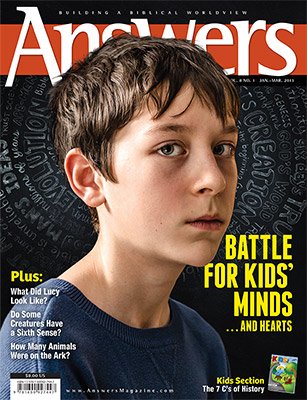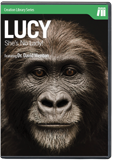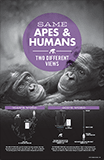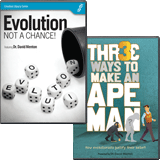Bringing Lucy to Life
She is the poster girl of human evolution, a member of the same family from which modern humans arose. At least, that’s how artists present Lucy in secular museums. As an artist building an exhibit for a creation-based museum, how would you present her?
Several years ago, the Creation Museum near Cincinnati began discussions to produce a new exhibit about one of the most famous fossils ever discovered—Australopithecus afarensis, commonly known as “Lucy.” Based on bones found in Ethiopia, secular museums worldwide have created hundreds of life-size models of this female primate. Lucy has been widely portrayed as the supreme example of a “missing link” between apes and humans, and she has even been referred to as the “mother of all humankind.”
Our main message is that biblical creationists and their evolutionary counterparts don’t disagree about the facts.
How should a creation-based museum showcase these bones? As a sculptor and exhibit designer, I met with Creation Museum founder Ken Ham and human anatomy expert Dr. David Menton to settle the question. We knew we wanted to create a three-dimensional, dynamic, and anatomically accurate display of Lucy that would clearly convey our message to museum visitors.
Our main message is that biblical creationists and their evolutionary counterparts don’t disagree about the facts. We have the same fossil evidences, the same data. Our disagreements are more about assumptions and beliefs—our starting points. These differences lead to our vastly different conclusions about what Lucy looked like.
Two Starting Points
Since evolutionists believe that all organisms came from a common ancestor, they automatically assume that humans evolved from an ape-like creature. They are looking for candidates wherever they can find them. That’s where Lucy, whose genus name, Australopithecus, means “southern ape,” comes in.
The desire to fill this gap is so strong that evolutionary paleontologists have interpreted the majority of apelike fossils to be human ancestors, known as hominids. When they look at a fossil like Lucy, they automatically assume that she must fall somewhere in the evolutionary timeline from apelike creatures to humans. Their only interest is to determine where she fits, not if. Depending on where they believe she belongs on that timeline, artists fill in the missing details to depict her as more or less humanlike.
Biblical creationists, in contrast, believe the history given by God in Genesis. Therefore, they believe the earth is young and humans were created on the sixth day of a literal, seven-day week. Land animals were also created on Day Six. Apes are land animals, so they were created on the same day as humans. When creationists look at an apelike fossil, like Lucy, they conclude that she must be either an ape or a human, but not something in the process of changing from one into the other.
The Challenge of Recreating Lucy
Unfortunately, there is very little fossil evidence to go on. Even though Lucy is fairly complete for a mammal fossil (47 of 207 bones found), the bones are mostly small fragments with many pieces missing. Other specimens have been found, but they are far more fragmentary. No matter how complete, all fossils must be interpreted. Some interpretation is always left to the imagination of the person doing the reconstruction.
Based on my first conversations about this new Creation Museum exhibit, the original concept was to show the evolutionary interpretation of Lucy side-by-side with the creationist interpretation. But when we began our research of evolutionary representations of Lucy, we did not find a consensus of what evolutionists think Lucy looked like. Instead, we found well over a hundred different interpretations, everything from perfectly ape-looking to almost human. Several were created following the very best methods of forensic reconstruction, but even they looked nothing like each other.
The question became, “If we want to fairly represent the evolutionists’ interpretation of Lucy, which one should we choose? And if we pick one, will it change?” We finally decided to have our Lucy standing on a pile of photos of different evolutionary models, allowing our visitors to pick their favorite if they disagree with our interpretation.
Lucy’s bones are not only broken but also missing many key features. For example, there is very little to go on to reconstruct her skull. It is completely shattered. All of her upper face is missing. So is the foramen magnum, the place where the skull attaches to the spine. Other specimens have been found with this part of the skull largely complete, but even they have to be reconstructed from fragments, which leave large gaps, allowing for several interpretations. Some evolutionists give her a small braincase, while others a large braincase. Most place the skull on the spine at a point where human skulls rest. However, those same pieces can be fitted together to depict a more apelike skull.1
These details influence the reconstruction of her posture and give clues about her preferred stance and method of locomotion. Did she walk upright like a human or on all fours like a typical ape? The shape of her skull plays into the conclusion, but so does every other piece of the puzzle.
The main reason evolutionists make Lucy walk upright is based, in large part, on a separate and unrelated find—a set of fossilized footprints from 932 miles (1500 km) away in Laetoli, Tanzania. Here, anthropologist Mary Leaky found a 73-foot-long (22 m) trail of footprints. The shape of the prints, as well as the stride, is clearly humanlike. Since evolutionists date these tracks as slightly older than Lucy, they attribute them to her kind.
Giving Lucy Long Legs
To produce the stride of the Laetoli footprints, the individuals who made the footprints must have had relatively long legs and an upright, two-footed (bipedal) gate. To ensure that Lucy’s bones fit their bias, evolutionists give her long, humanlike legs and very humanlike feet. Since all of her long bones are fragmented, there is a little leeway in estimating the original length of her arms and legs. But sometimes evolutionists have added as much as half a foot (15 cm) into the gaps. On a 3-foot (1 m) frame, that adds a lot of height!
It is important to understand that Lucy’s broken leg bones would actually fit together just fine with short, apelike proportions. A young-earth creationist has no problem depicting Lucy as some sort of extinct ape, so that’s how we present her at the Creation Museum. The Laetoli footprints could easily have been made by humans who scattered from Babel, after Noah’s Flood.
Ape or Ape Man?
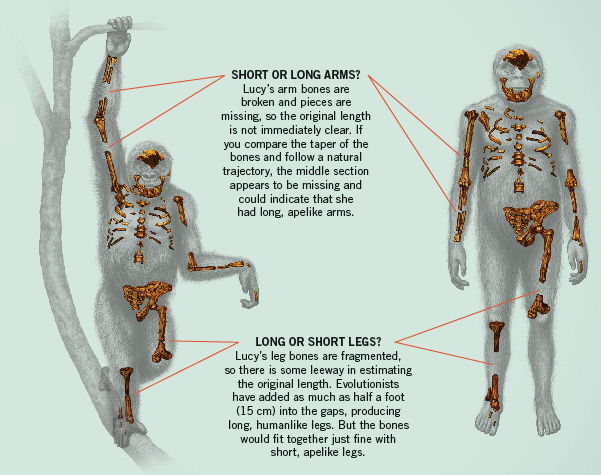
Illustrations by Ben Iocco
What did the fossil creature known as “Lucy” look like when she was alive? The problem is that all the longer bones were fragmented. If a scientist believes Lucy was a link between apes and humans, the gaps between her arm bones can be closed and the gaps between her leg bones can be lengthened to give her humanlike proportions. But the bones fit together just as well with ape proportions.
Giving Lucy Short Arms
Lucy’s arms are another part of her body where bias directs reconstruction. Her arm bones are broken and pieces are missing, so interpreters are able to justify varied lengths, depending on whether they believe she was apelike (longer arms) or humanlike (shorter arms).
For years evolutionists have depicted Lucy’s hands and feet as being human-like. Recent discovery of specimens with hand bones has led evolutionists to acknowledge that she had more apelike hands, with long highly curved fingers, but so far their depictions of her feet remain humanlike because of their strong beliefs about the Laetoli footprints. Despite this advance, very few evolutionary museums have invested in updating their Lucy models. So, many visitors walk away believing whatever the artist has shown. Often the best artwork or the flashiest computer graphics win the day. Truly the artist has an inordinately powerful influence over the viewer.
“Make-Up” Artists
Few people realize how much interpretation goes into reconstructing a fossil like Lucy’s. In evolutionary museums, the choices for posture, skin color, and the thickness of body hair are largely determined by how close she appears to humans on the evolutionary timeline.
It is important to note that none of these features are preserved in the fossils. So the next time you see an artist’s drawing or model of one of our supposed ancestors, pay close attention to the finishing details. Which of the artistic choices that make the specimen look human were actually found in the fossils?
For instance, no eyeballs have yet been found. Did the artist give the model humanlike eyes or are they more apelike? Only humans have a white sclera producing the “whites of their eyes,” so if you put a white sclera in the eyes of an ape (apes usually have dark brown sclera), it instantly looks more human.
A Lucy Makeover

Artists’ efforts to design faces from fossils aren’t all science. This work requires lots of imagination to fill in the blanks not preserved in the fossil record—skin color, hair color, eyes, thickness of hair, etc. Indeed, these choices are heavily influenced by the effect the artist desires. Cincinnati’s Creation Museum shows several ways that an artist could take the same mold of Lucy’s head (center) and create very different impressions, simply by choosing different colors and hair patterns. Which of these four seem to be most humanlike, and why? While some look reasonable, it is more likely that she did not resemble any of them!
Is the nose sculpted to look more human or less human? How thick is the body hair? What is the posture? These details—and many others—are not found in the fossil remains.
Based on Genesis 1, biblical creationists recognize that humans and apes were never related. So we naturally conclude that Lucy was not on her way to becoming human. This viewpoint guides our interpretation of the fossil evidence.

PhotoResearchers.com (from left to right): Lionel Bret; Javier Trueba | MSF; Philippe Plailly & Atelier Daynes; Mauricio Anton
There are well over a hundred different interpretations of Lucy. Notice how subtle changes in eye color or nose shape can make her look more or less human. Even the expression on her face or the child in her arms influences our impression of her.
The Creation Museum team spared no time or expense to produce the most careful, accurate portrayal we could, clocking thousands of hours and placing every individual hair. Yet no matter how we choose to show her, we do not want people to think, “This model is exactly what Lucy looked like!” Our goal was simply to construct the best model that is consistent with the fossil evidence and with a literal understanding of the creation account in Genesis.
And that is a major point we wanted to make with this new exhibit. Yes, the exhibit is about Lucy, but it communicates much more than that: Christians need to trust God’s Word as their final authority. The Scriptures never change. We don’t build our faith upon models and reconstructions, which may change as we learn more. Creationists want to understand more about the Creator’s handiwork in the design and diversity of apes and the uniqueness of man, which speak of His majesty.
When we put our trust in the One who made us, we can expect to find a rational and defendable interpretation of the evidence set before us, including a little ape named Lucy.
Answers Magazine
January – March 2013
Learn about our culture's newest tactics in the battle for kids' souls, and discover what you can do in your home and church to reclaim our youth for Jesus, the Creator. In addition to this special section of three articles, you'll find all the creation content you expect from Answers magazine, including a look at Lucy, the famous ape; animals with "sixth senses"; ancient and modern reefs; and intriguing findings about the animal kinds on Noah's Ark.
Browse Issue SubscribeFootnotes
- Elizabeth Mitchell and David Menton, “Lucy, the Knuckle-walking ‘Abomination’?,” Answers in Genesis, https://answersingenesis.org/human-evolution/lucy/lucy-the-knuckle-walking-abomination/
Recommended Resources

Answers in Genesis is an apologetics ministry, dedicated to helping Christians defend their faith and proclaim the good news of Jesus Christ.
- Customer Service 800.778.3390
- © 2025 Answers in Genesis



